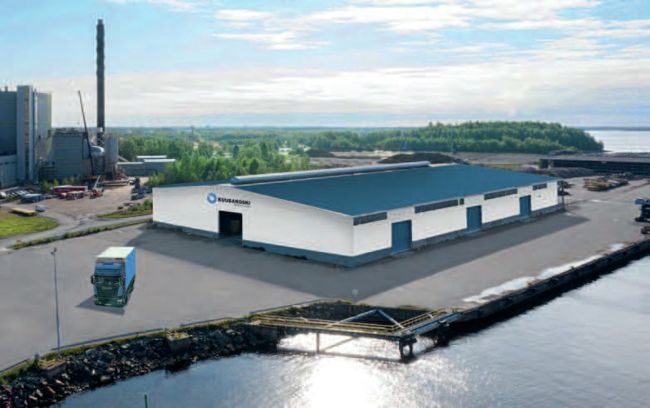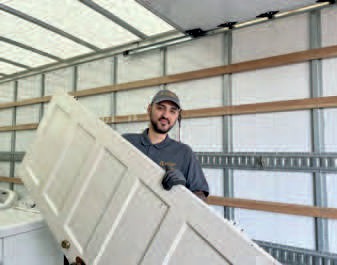MATERIAL PASSPORTS
A whole new challenge...
We take a look at what material passports mean for demolition and recycling and how the industry in responding.

The house Büscher built with prefab elements of recycled natural mineral substitutes
PHOTO: KEESTRACK
In aworld full of buzzwords and jargon, material passports are one of the more straightforward concepts to emerge. In the same way as a passport enables and records an individual’s journeys through their lifetime, a materials passport does the same for the life of a building, or more accurately of its constituent parts.
And when the time comes for that building to be demolished – or as is increasingly favoured – deconstruction or refurbishment, there will be a full log of what materials have been used and what can happen to them next.
So against this background, how are the demands on the demolition and recycling industry changing, and just as importantly, what is the sector’s response?
We pick out five of the latest examples.
THE CITY THAT WANTS TO AVOID DEMOLITION ALTOGETHER
Developers in the City of London, United Kingdom, will be asked to consider alternatives to demolition at the earliest stage of the planning process in a bid to reducing the Square Mile’s carbon footprint.
The City of London Corporation is the first planning authority in the country to issue planning guidance expecting developers to carry out a detailed review of the carbon impact of development options before submitting an application.

The City of London Corporation’s Shravan Joshi called its new guidance ‘pioneering’
PHOTO: CITY OF LONDON CORPORATION
This includes considering refurbishing existing buildings rather than knocking them down and replacing them with new structures.
City of London Corporation Planning and Transportation Committee chairman Shravan Joshi said: “This pioneering planning guidance puts the City at the forefront of the growing drive to give substantial, detailed consideration to retaining and refurbishing buildings rather than simply knocking them down and starting from scratch.”
The guidance applies to major developments – those greater than 1,000 sq m (10,763 sq ft) of floorspace – and developments which propose knocking down most of the existing structure.
THE HOUSE BUILT WITH RECYCLED CONSTRUCTION AND DEMOLITION WASTE
German company Büscher has built a complete house out of 75% recycled construction and demolition waste, with load-bearing and non-load-bearing interior wall elements made of 100% recycled aggregates – with the help of crushing and screening equipment from Belgium-based manufacturer Keestrack.
Described as the first company to achievec
this, Büscher – which started out making concrete more than 60 years ago – gained approval from the Deutsches Institut für Bautechnik (DIBt, or German Federal Association for Building Materials) for its innovative approach.
It took eight years of research and development to prove the house could be sustainably built, even at lower costs, but only four months to construct the threefamily home with paint-ready prefab elements.
And while the use of recycled materials does not extend to the outside walls, Büscher has already thought ahead to the house’s eventual demolition, when the inside walls will be recycled into new concrete and re-enter the circular economy.
THE COMPANY INVESTING IN ‘CARBON-FREE’ STEEL RECYCLING
A recycling company in Finland is planning to invest €25 million (US$27 million) in building a steel recycling plant that it says will operate 100% carbon free.
The plant, which will be located in Veitsiluoto, around 750 km (466 miles) north of the capital Helsinki, will link sea freight to rail and road transport.
Kuusakoski said the carbon-free plant – which it claims is the first of its kind – will respond to growing demand for recycled materials in both Finland and Sweden, while investing the company’s own recycling capacity by 25%.

Artist’s impression of the Kuusakoski plant in Finland
It is part of a green investment programme under which the company aims to have carbon-free operations by 2035.
“In Veitsiluoto we are close to our largest end customers, and can offer superior, smart delivery models and competitive delivery times”, said president and CEO Mikko Kuusilehto.
“We are seeing the steel industry beginning to move towards carbon free production. Our new plant will bring with it carbon free processing, which will enable our customers to further reduce their climate impact throughout the value chain.”
With the investment, Kuusakoski’s customers will have the opportunity to use even more precise carbon footprint calculations and cleaner recycled steel in their production, which can further reduce the carbon footprint of steel products.
The building of the plant is planned to begin next year.
The new plant is scheduled to be in operation in 2025 and once in operation it will employ approximately 20 people.
Of the €25 million total investment, €2.8 million ($3 million) will be financed by Business Finland from RRF (Recovery and Resilience Facility) funding.
THE CONTRACTOR APPLYING ‘CARBON ENGINEERING’ TO DECONSTRUCTION WORKS
United Kingdom-based specialist engineering contractor McGee has been appointed by built environment investor Castleforge for deconstruction works at a site in the City of London.
McGee has used its carbon engineering expertise to develop an approach which allows the deconstruction and de-fabrication of the existing structural steelwork from the 1980s building, which means it can be recertified, refabricated and reused in the new proposed structure at 1 Golden Lane. The company said this approach enables the proposed extension to emit less carbon than other structural solutions.

The 1 Golden Lane project builds on McGee’s experience at listed sites in London.
At the Golden Lane site, the work will see half the original building – which dates from the late 19th century – retained in its current form, with the deconstruction works taking place alongside it.
The proposed refabrication involves ribbon cutting the existing beams to increase the stiffness of the section.
McGee worked with the designer, industry bodies and Castleforge to demonstrate the viability of steelwork reuse in this scheme to reduce carbon emissions and ensure the protection of the original building.
This complex scheme builds on similar work by McGee at listed sites throughout London including Admiralty Arch and Claridge’s Hotel.

A worker unloads items from a deconstruction project at a reuse store in Edmonston, Maryland
PHOTO: KUUSAKOSKI RECYCLING PHOTO: MCGEE GROUP
THE US COMMUNITY HELPING TO SAVE 350,000 TONNES A YEAR FROM LANDFILL
The cavernous Maryland warehouse housing Community Forklift bulges with doors, windows, flooring and light fixtures.
Some have been used more than others, but all are for sale at big discounts.
Dozens of customers browsed the wares on a recent weekday morning, part of a growing drive to keep building materials out of landfill and in the economy – with a range of important climate, sustainability and social benefits.
“In any building being torn down, there will almost always be some elements that are still valuable,” Community Forklift executive director Trey Davis told the Thomson Reuters Foundation.
“But if you really want to attack the volume of stuff going into landfills, you have to do the everyday stuff.”
Since the non-profit warehouse was founded in 2005, it has helped pioneer a model now spreading across the USA, fuelled in part by local officials keen to reduce pressure on landfill sites and bolster the economy.
San Antonio, Texas, introduced a building deconstruction requirement in January, following cities such as Milwaukee in Wisconsin in the American midwest and Boise, Idaho and Portland, Oregon, in the west. Similar proposals are being debated in Baltimore, Maryland and elsewhere.
Community Forklift has grown with the trend, now employing about 30 people with an annual budget of around $3 million.
Last year, donations and in-house deconstruction crews helped keep a mountain of goods from landfills – including 3,400 doors, 10 km (6.6 miles) of lumber, and 7,000 sq m (74,000 sq ft) of tiles.
Full story of Community Forklift at www.demolitionandrecycling.mediaReporting by Carey L Biron, original editing by Jon Hemming. The Thomson Reuters Foundation is the charitable arm of Thomson Reuters. ■